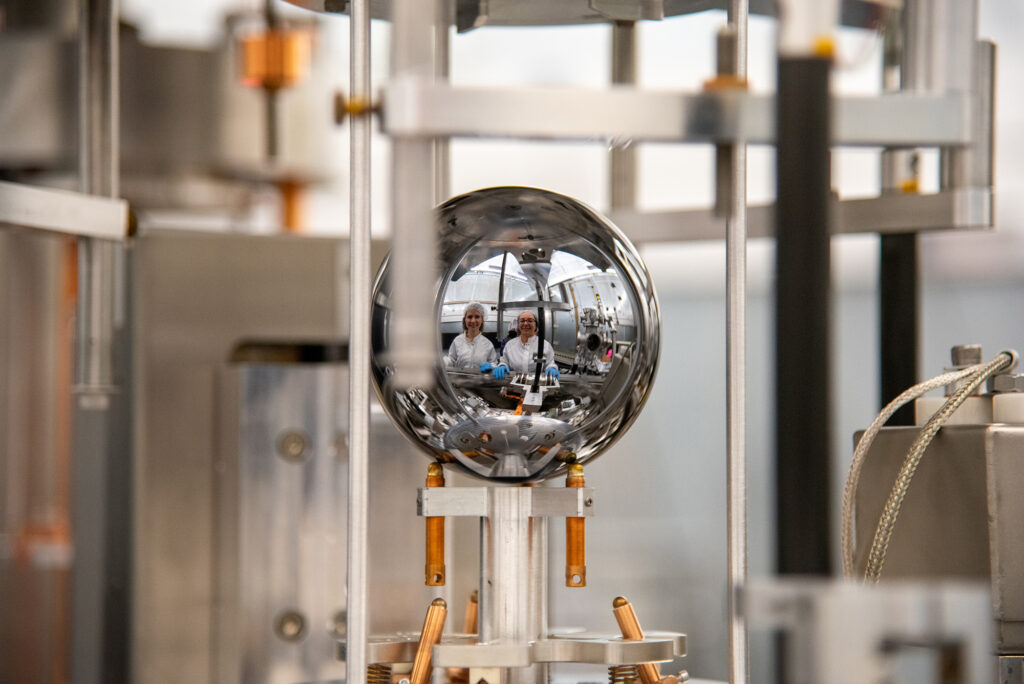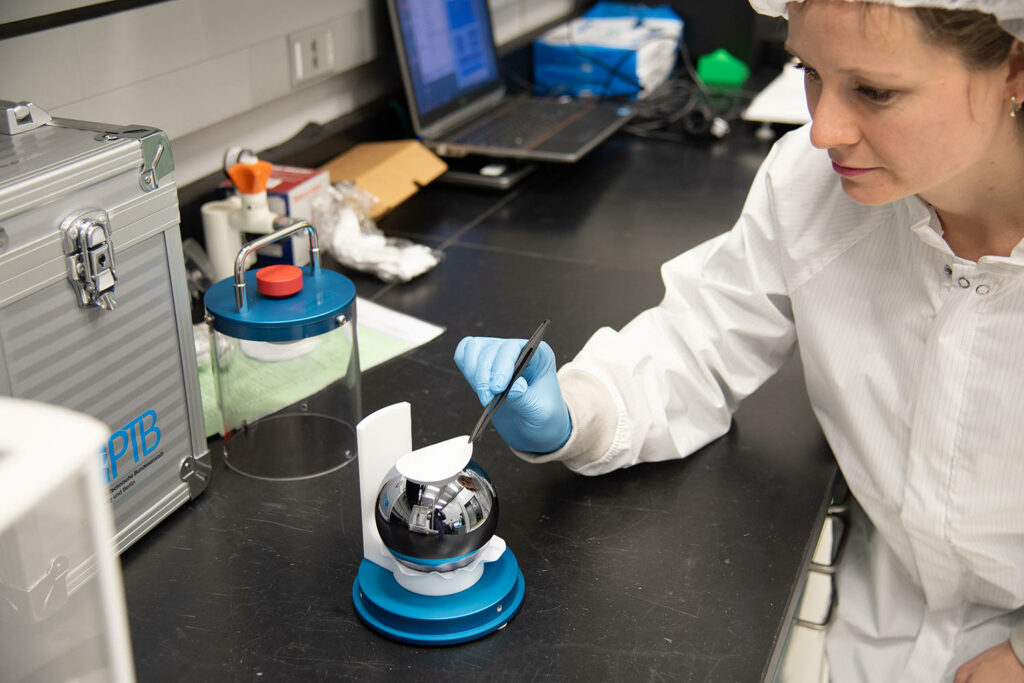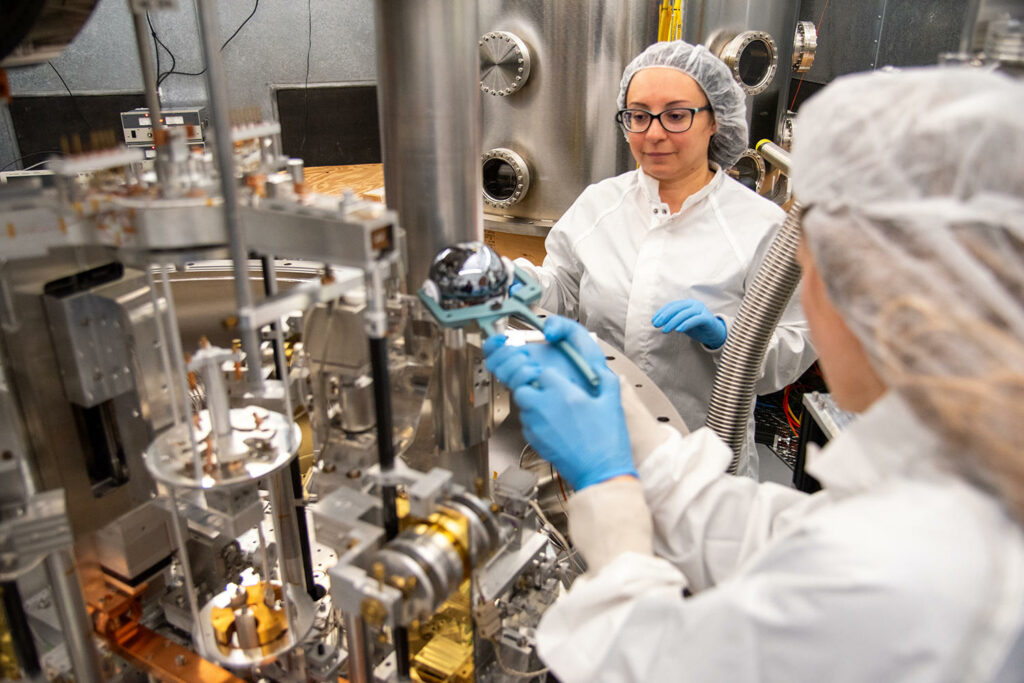
This perfectly measured silicon sphere is one of the roundest objects on Earth—and it’s helping researchers figure out how to best calculate the value of the kilogram. (Photo courtesy B. Hayes/NIST)
By Megan King
The following article was originally published by the National Institute of Standards and Technology.
In 2018, the world agreed to redefine the kilogram. Instead of being pegged to the mass of a physical object in a vault in France, the kilogram is now defined by a few fundamental constants in nature.
This means researchers no longer have to worry about a physical object that can decay or change over time, potentially throwing the world’s measurements into chaos.
Like any unit of measurement, the kilogram needs to be the same for everyone, all the time. Theoretically, it can now be measured in any lab in the world using the Planck constant—which defines how small things can be. That measurement can be shared with anyone who needs to find out the mass of an object.
But in reality, it’s not quite that simple—yet.
The transition from using a physical object as the kilogram definition to a natural constant has meant differing approaches to defining (or “realizing,” as researchers call it) the kilogram for different countries.
Countries have their own approaches to the definition, and there’s a slight variation in their measurements. Ideally, everyone would get the same result within a reasonable range, no matter what method they actually use to take the measurement.
The International Bureau of Weights and Measures (BIPM) currently distributes a consensus value that countries use to define the kilogram. Once we get to the point that various approaches to the definition don’t result in a significant lack of agreement in everyone’s results, BIPM will no longer have to distribute this value of the kilogram.
So NIST researcher Darine Haddad, along with Beatrice Rodiek from Germany’s national measurement science institute, known as the PTB, and their colleagues, are working together to figure out why the approaches are leading to different outcomes.
Right now, the U.S. has an exquisitely accurate weighing system, known as a Kibble balance, that uses quantum mechanics to precisely measure mass to get the official definition of the kilogram. Germany, on the other hand, uses a method that means, in simple terms, “counting atoms,” as Rodiek explained. It’s called the XRCD method.
Each approach gets to a slightly different definition of the kilogram. The variations in their results are tiny—about 50 micrograms, which is the approximate mass of a grain of salt.
So, a 50-microgram difference in measuring a kilogram is a bit like weighing a pineapple on two scales, and your measurements only being off from each other by about a grain of salt! You’d think that’s close enough, but Haddad and Rodiek are trying to close that tiny gap.
“If you have two completely different approaches measuring the same object, and you get the same results, you can trust them,” Haddad said. “Once we get to that point, everyone can directly measure the unit of mass with the primary definition. These are small gaps we’re talking about here.”

German researcher Beatrice Rodiek prepares “the sphere”—one of the roundest objects on Earth—to be measured on a highly accurate weighing machine, known as the Kibble balance, at NIST’s campus in Gaithersburg, Maryland. (Photo courtesy B. Hayes/NIST)
A Sphere of Measurement Influence
Rodiek recently traveled to NIST’s campus in Gaithersburg, Maryland, to run a series of measurements and tests to see how the two countries’ approaches may be able to get closer to the same results.
Rodiek brought along one of the roundest objects on Earth—a perfectly manufactured silicon sphere.
First, Rodiek had to follow a special procedure to clean the sphere, so the researchers could avoid dust and other minute deposits on the mass of the sphere affecting the measurements. Then she very carefully walked it to the Kibble balance and placed it on a robot arm.
Haddad tried to run the Kibble balance experiment, but there were challenges along the way. The main issue was that the Kibble balance had not previously measured a spherical-shaped object and had to be adjusted to take that measurement.
Each time the researchers had to tweak the Kibble balance, the sphere had to be cleaned and gently put back in place. It was a tedious process that took up most of Rodiek’s weeklong visit to NIST in April.
Rodiek and the sphere have since returned to Germany. The sphere travels in its own protective case with Rodiek as her carry-on, never in checked luggage. The cargo is too precious to jostle.
“Sometimes it’s a little scary traveling with it in the airplane. You never know if we’re going to hit some turbulence, and it’s just sitting there. Luckily, it’s pretty robust, and we can always clean it,” Rodiek said.
Haddad and Rodiek are planning another series of experiments and, hopefully, will be able to make all needed measurements, without the technical difficulties.
“I’m really excited to come back. I’m planning another trip when we’ll have a bit more time to do these measurements,” Rodiek said.

Right now, the U.S. and Germany have different approaches to defining, or “realizing,” as the researchers call it, the kilogram. Here, NIST researcher Darine Haddad looks on as German researcher Beatrice Rodiek places a sphere on NIST’s highly accurate weighing machine, the Kibble balance. The goal of the research is to get closer to the same definition using the different methods. (Photo courtesy B. Hayes/NIST)
Why More Research on the Kilogram Is Needed
You may be wondering why all this effort is required to measure something accurately within a grain of salt. I wondered that, too. I asked Haddad: Why is this even necessary?
In addition to living up to the spirit of the redefinition of the kilogram—that anyone in any lab should be able to define the kilogram as accurately as possible—Haddad said we have no idea what we might learn from these experiments.
And as a scientist, that’s exciting for her. Researchers need to understand why this gap in the measurements is occurring, and who knows what we might learn from that.
“For researchers, science is very interesting for us, and we just want to understand why. Is there a scientific reason?” she said. “The knowledge we get from these experiments, discovering why the errors happen, can help us improve measurement science going forward.”
This article was originally published by NIST in its blog, Taking Measure.
About the author
Megan King is a writer-editor at NIST and edits the Taking Measure blog. After graduating from John Carroll University, she began her career as a newspaper journalist, covering county fairs and school board meetings. Megan worked in various communications roles at the FBI for 13 years, including as a content manager and strategist for fbi.gov. Outside of work, Megan coaches beginner ice skaters, cheers on Pittsburgh sports teams, and knits.
